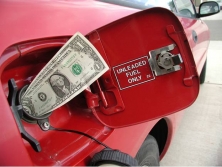a column written for the East County Magazine
“Your guide to financial planning & socially responsible investing”


By Judith L. Seid, CFP ®, President, Blue Summit Wealth Management
April 24, 2011 (San Diego’s East County) -- Friends, we need to view current gas prices as the “new normal” and not assume that this is a temporary condition. Most people were shocked at the gas prices when they rose in 2008, but this time they are not nearly as shocked and upset, even though prices are surpassing 2008 levels.
I think this is because they have seen it before, and the second time around is much less shocking. As well, most people understand that gas prices in other parts of the world are much, much, higher…for example in England gas is equivalent to about $8 per gallon, so we are now only at about half that. People there have adjusted and people here will too. Just accept it as a part of your living expenses…the new normal.
We could get into a long discussion about how the price of gas does not reflect its true cost…see this study discussing external costs & subsidies of gasoline done in 1998 by the International Center for Technology Assessment (CTA) here: http://www.icta.org/doc/Real%20Price%20of%20Gasoline.pdf
“Together,these external costs total $558.7 billion to $1.69 trillion per year,which,when added to the retail price of gasoline, results in a per gallon price of $5.60 to $15.14.” and that was when gas prices were much less.
That report doesn’t even take into consideration the environmental costs that a full cost accounting would (also called true cost pricing): http://en.wikipedia.org/wiki/Full_cost_accounting And I like this authors view in 2008: http://www.recordonline.com/apps/pbcs.dll/article?AID=/20080608/NEWS/806... where he says: “One thing has become clear. If Americans had to pay the true cost of fuel at the pump, we would all ride bicycles and drive electric cars.”
Here are some steps you can take:
First, get used to it. It is important that people don’t let themselves get overly emotional and upset when gas prices are something they can’t control, so as with all things in life, simply control what you have control over.
Calculate how much each dollar increase in gas prices is really affecting you, perhaps you are getting upset for no good reason. For example, most people drive about 15,000 miles per year, so if your vehicle gets 20 miles/gallon you are buying 750 gallons/yr. If gas prices go up $1/gallon, then you are spending $750/yr more or $62.50/month or about $15/week more in gas.
If an adjustment is needed to keep your spending in line with your income, the first option most people might think about is to cut back on their driving. For some people this isn’t possible, as they may have a job that requires driving, but for others, just being aware of their driving habits may enable them to cut back on unnecessary trips. People can do things such as:
1) Carpool when possible
2) Combine errands so that you take less trips
3) Ride bike to work & for errands (this is my favorite, since I am an avid cyclist!)
4) Take public transportation – a trolley pass is only about $72/month
5) Walk
In addition, people should take a look at where they live in relation to their work, sometimes it is possible to move closer to work, closer to the freeway, and/or closer to the trolley/bus.
Can you work from home, even if only one day per week?
Consider your next vehicle. If you are ready or close to ready for a new vehicle purchase, consider an electric or hybrid vehicle.
The next thing is to compensate other areas of your spending plan/budget. To do this, list all monthly expenditures, then see if there are any areas that can be trimmed, here are some items to consider:
1) Eat out less (brown bag to work, prepare meals in bulk, freeze them for easy quick reheating, etc)
2) Cell phone plan – revisit to see if you can save money
3) Cable tv plan – revisit to see if you can save money
4) Clothing – shop at discount stores or better yet, second hand stores.
5) Clip coupons for food items
Just getting a handle on your spending plan is a great exercise no matter if we are in a period of rising gas prices or not. Perhaps this will motivate people to do some much needed, overdue planning. (If you need a worksheet for help in doing this, we will be happy to forward one free of charge: info@bluesummitwealth.com) Really detailing what take home pay you have and what all your total expenses are (including those that are annual such as DMV, property taxes, insurance, etc) can be an eye opener for most people.
So perhaps if people are motivated to do some planning work, dig in and take a look at where ALL their money is going, find other expenses they can cut back on, trim the fat, cut the waste, then it could be that the rise in gas has the potential to be helpful to their financial bottom line! Now how is that for positive, glass if half-full thinking!
For more information on Financial Planning & Sustainable Investing, contact Judith at
Blue Summit Wealth Management in La Mesa, (619) 698-4330; www.BLUESUMMITWEALTH.com
Securities offered through Pacific West Securities, Inc. (Pacific West) Member FINRA/SIPC. Advisory services provided through Pacific West Financial Consultants, Inc. and Blue Summit Wealth Management, Inc. (Blue Summit), Registered Investment Advisors. Blue Summit and Pacific West are not affiliated.











Recent comments